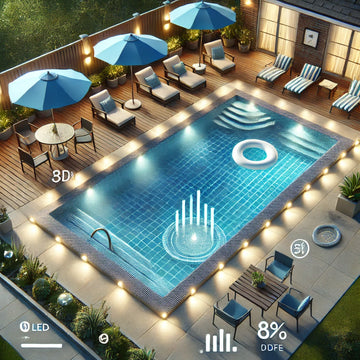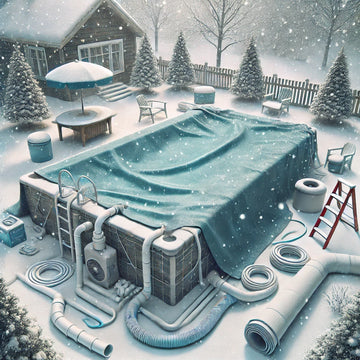Tips for Carrying Out Mid-Winter Pool Maintenance
When it comes to winterizing your pool, it’s not a ‘set it and forget it’ until spring kind of deal. After the pool cover goes on and you’ve taken proper steps to winterize your pool, you’ll need to do a thorough check-in with your pool mid-way through the season to check for any issues that may have come up.
The Importance of Checking in With Your Pool Mid-Way Through Winter
A mid-winter pool check-in ensures your pool stays in good shape all winter long. It allows you to catch any issues with your pool and equipment early on before they worsen and become costly problems.
When to Do Your Check-In
Technically, the middle of winter is February 5th. And while you don’t have to do the mid-winter pool check-in on the 5th, aim to do this check-in within a week or so before or after.
Mid-Winter Pool Check-In Checklist
Follow these winter pool care steps for your mid-winter check-in:
Check to Make Sure Your Cover Is Secure
A properly fitted pool safety cover is key to having a clean pool when you open it in the spring. So, make sure your pool cover is secure to keep dirt, debris, contaminants, and small animals out of your pool during the winter.
If any contaminants get into the water, they can end up staining your pool and causing algae growth once the weather warms up.
Be sure to follow these winter pool cover tips:
[su_list icon=”icon: tint” icon_color=”#04cee9″]- Check your pool safety cover for holes and tears and repair immediately with pool cover patches.
- Remove debris from the cover with a telescopic pool and leaf rake or net, and remove leaves stuck beneath the edge of the cover and straps.
- For automatic safety covers, pump out any standing water (specified automatic as regular safety cover a mesh made and water flow trough)
For in-ground pools with water bags, check if the bags are full and have remained in place. If using a pool safety cover, check that all the anchors are secure in the pool deck or surrounding pool area. The cover springs should be about halfway compressed.
And if using a winter pool cover, check around the perimeter of the pool to see if the cover has moved. Adjust the cover if necessary to make it secure.
Any gaps between the pool cover and the pool wall will be a hazard for contaminants and small animals to fall through. So, adjust the covers to seal the pool securely. And if that doesn’t work, use heavy foam or pool noodles to block the gaps.
Check the Filter and Electrical System
Check that:
[su_list icon=”icon: tint” icon_color=”#04cee9″]- All breakers and time clocks are turned off
- The pool light is turned off
- There are no leaks or cracks in and around the electrical equipment
- All the wires are properly connected to the pump, heaters, sensors, and other equipment
Check the Water Chemistry
Test the water chemistry—pH, calcium hardness, alkalinity, etc.—and adjust the levels as needed. Then add a winter chlorine shock to distribute chlorine throughout the rest of the winter.
Check the Pool Equipment and Plumbing
If you didn’t disconnect the pool equipment and plumbing during pool closing, inspect these for freeze damage. Check the pool filter, pump, heater, other pool equipment, and plastic plumbing for cracks. And consider using equipment covers for a layer of protection from winter freeze damage.
Also, check:
[su_list icon=”icon: tint” icon_color=”#04cee9″]- That the drain plugs are removed from all of the equipment, including the pool filter
- The pool skimmer protection tube or gizmo is secure to prevent water from entering the plumbing system
- The winterizing plugs are in place for the return valves or lines
Examine Your Pool’s Surface
Pull back the pool cover onto itself to examine the pool’s surface. Look for signs of cracking, stains, discolouration, and waterline marks. If you have a concrete pool, check the tile and coping stones for cracks or movement.
If possible, repair any damages and add an off-season enzyme to the water to break down organic contamination that causes stains and waterline marks.
Check the Water Level
Check the water level to make sure it isn’t too high or too low. The ideal water level is about six inches below the tile for safety covers, four inches below the tile for solid covers, and mid skimmer for duck plug system or four inches below the skimmer for vinyl pools.
If the water is too low, it might indicate a leak in your pool, and it won’t support your pool cover during heavy snowfalls. With low water, your pool cover will be at risk of sinking into your pool and getting damaged. So, add water with a garden hose if needed.
If the water level is too high, freezing water could put pressure on the tile and cause damage. High water might also start pooling on your cover and collecting leaves. The tannins from the leaves can then leach into the pool water and stain your pool.
So, remove excess water from your pool by placing a small cover pump into your skimmer or on the top step in the shallow end of your pool.
Clean Up the Pool Area
Trim any trees or shrubs that are hanging over the pool area to prevent debris from falling onto your pool. And remove any leaves and debris that have already fallen around your pool to prevent staining of your pool deck.
Add an Algaecide
Add a mid-winter algaecide to your pool that will last for a while. This will help prevent algae from growing in your pool once the temperature starts to warm up. You may also want to add an algaecide and chlorine shock in early spring to ensure your pool stays clean before opening.
Keeping an eye on your pool throughout the winter will ensure it stays in good condition, saving you plenty of time, money, and stress come pool opening.
A small issue in the middle of winter can worsen and end up taking more time and money to fix in the spring. So, be sure to address any problems you come across during a mid-winter check-in and protect your pool, so you won’t have any delays once the warm weather arrives.




